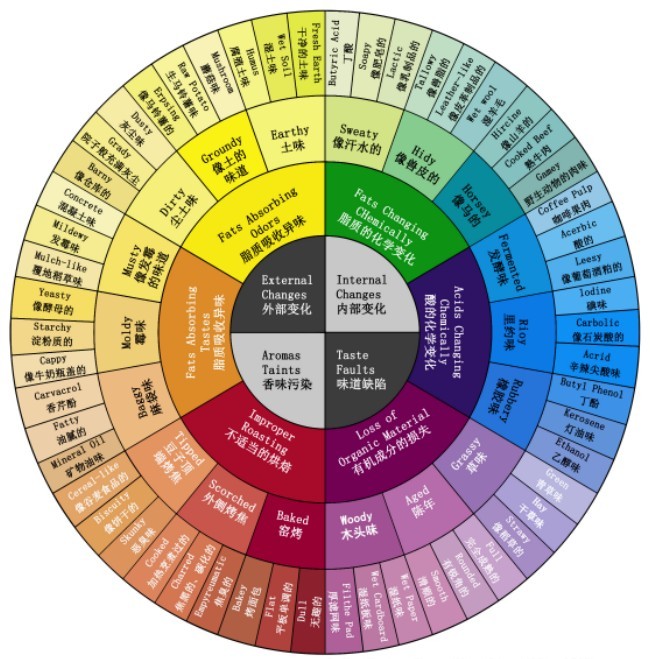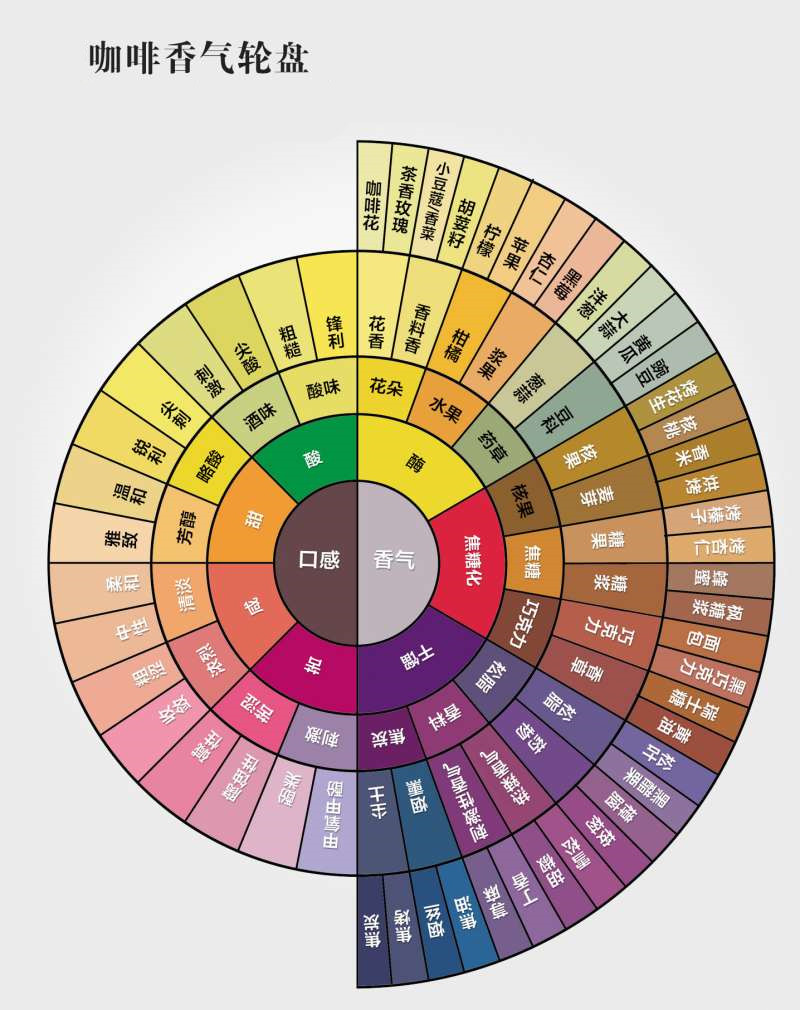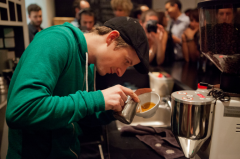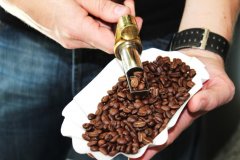Coffee Bean roasting Coffee roasting and Coffee Flavor Wheel
Deep baking highlights wood incense
Light baking can highlight the bright smell of sour flowers, grass and fruit, but hopeless deep baking fans fall in love with resin components such as incense, smelly, choking aroma and alcohol smell, which is the product of Mena reaction and dry distillation. (resin composition: pine and cypress Pinaceae and Taxodiaceae, both secrete olefins with spicy fragrance to protect against pests or squirrels.) "dry distillation" means that solids or organic matter isolate the air and dry until it is completely carbonized. The purpose of air isolation is to prevent oxygen from burning or exploding.
Taking the dry distillation of wood chips wrapped in tin foil as an example, charcoal can be made and coke choking products such as formaldehyde, acetic acid, tar and gas can be formed. Although coffee roasting is carried out in a semi-closed drum or metal tank, oxygen can still go in and out, unlike dry distillation and oxygen-free smouldering environment, but under normal roasting conditions, coffee beans cannot be roasted to full carbonization, so the dehydration, pyrolysis, dehydrogenation and coking experienced before re-baking beans are similar to dry distillation, and medium-baked beans will also produce a lot of scorched or pungent odors. Therefore, the deep accompany aroma can be attributed to dry distillation.
The shallow and medium baked aromas belong to low and medium molecular weight, but they enter the deep baking world after the second explosion, carbonization intensifies and caramelization disappears, but the Mena reaction continues, and the fibers of amino acids and polysaccharides continue to explain and polymerize to produce more high molecular weight adhesive compounds. the right of aroma interpretation from caramel is dominated by Mena reaction and dry distillation reaction, mainly coke and smelly.
Americans often say: "One man's meat is another man's poison", that is, some people regard it as delicious and others regard it as poison. The "aroma spectrum" of dry distillation is divided into three categories: resin rhyme, spicy rhyme and carbonized rhyme, as follows:
1. Resin rhyme: turpentine and choking drug flavor
Turpentine: turpentine, chicory, mahogany, alcohol, blackcurrant branches and leaves
Choking medicine smell: Rosemary, cineol, Eucalyptus leaf, camphor
two。 Xin Xiang Yun: warmth and choking incense
Warm: Cunninghamia lanceolata, cedar, celery seeds, pepper, nutmeg
Choking incense: cinnamon seed, clove, bay leaf, bitter apricot, thyme, pepper
3. Carbonized Rhyme: choking and Ash
Smoke smell: tar, tar, tires, tobacco
Ash smell: scorched, coke

Mixed aroma of pine fir
The flavor wheel classifies the spicy flavors such as rosin and koala's favorite Yugali leaves as the aroma of dry distillation. However, this kind of spicy fragrance is not a patent for deep baking, and it often occurs when it has not yet entered the second explosion.
Recently, the cup tester in the United States is the "extraordinary Cup" winning coffee from Narino and Huila in southern Colombia, and El Salvador's national treasure varieties fear Kamala (Pacamara), Kona Hawaii and Mantenin, sometimes with pine flavor (Piney), and the garden beans of well-known Honduran farmers also have the aroma of Eucalyptus, which is puzzled. After heated discussion by experts, the final conclusion is that Coincidentally, these coffee farms all have pine, fir or Eucalyptus trees, which may be the source of pine aroma. However, there are still some experts who do not believe that if pine, fir, camphor or eucalyptus trees are planted near the coffee tree, the spice will be absorbed by the coffee seeds and become volatile after baking and can be smelled by the nose. I have to say that this adds a little surprise to romantic coffee.
Should turpentine be added or deducted? There are also different voices in the industry. some people think that turpentine is a disgusting odor, but others think that the presence of pine fir can increase the sense of hierarchy. To be fair, the elegant pine aroma of coffee is not bad as long as you don't choke your nose. To know that coffee beans are hard fibrous, and how much they taste like wood or pulp, there is a problem with beans used in commodities in the plains of Brazil. In contrast, more than 1500 of high-quality Arabica beans emit light and warm furniture pine wood after brewing, which is better than rotten wood.
As for the annoying smell of carbonized smoke from deep-baked beans, it is mostly caused by the accumulation of carbonized particles in silver skin or fiber, and the other part comes from high molecular weight volatile heterocyclic compounds and phenolic compounds. Therefore, the rosin made by dry distillation. In the spicy and carbonized smell, as long as the choky taste is effectively controlled to highlight the elegant rosin, snow-capped fir, and even the slight smell of alcohol in turpentine, applause should be given.

Cellulose is the source of ten thousand fragrances
The above is the "smell spectrum" of the reaction between dry distillation and Mena after the second explosion, which seems to be quite frightening, with the smell of turpentine and carbonization. However, the medium-to-deep roasting to deep baking after the second explosion is the most acceptable baking degree for the general public, especially in southern Taiwan, where shallow and medium-roasted sour aromas are not popular in the coffee market where they are afraid of bitterness.
This year, Europe and the United States blew the "third wave" whirlwind of boutique coffee, mainly from shallow medium roasting to medium to deep roasting, rarely to the deep roasting of the second burst tail (Agtrron#30~40) or the end of the second explosion (Agtrron#20~30), but the baking degree of the second burst tail was the characteristic of the "second wave" of fine coffee more than a decade ago. the bean surface oil is bright, and if the technology is good, it is not only not scorched but bitter, but also exudes the sweet smell of mellow wine and turpentine. Similar to the choking aroma of banana oil (isoamyl acetate), turpentine, cedar or nutmeg, but also like the warm aroma of home pine furniture, every cold winter, a cup in hand, warm on the heart.
The famous Catte D'arte in Seattle in the United States is a typical example of choking incense. The extracted espresso has the smell of alcohol and cedar aroma, which is very charming.
Recently, scientists have found that the strong aroma of medium-and deep-roasted coffee comes not from the caramelization of sucrose, but from the polysaccharide cellulose in the thick cell wall structure of raw beans, which is the "hotbed" of Mercaptan compounds, which is the main source of the strong aroma and alcohol smell of ripe beans.
"mercaptan" creates deep roasted fragrance
Since 1962, two Nobel laureates, Reichstein and Stottinger, pointed out that uran, mercaptan, and alkylpyrazine. In fact, scientists have made great progress in this area over the years after Diketone is the key to creating the aroma of coffee. Scholars such as Thomas Palerman (Thomas H Parliment), a chemist from the world-renowned Kraft Food Company (Kraft Foods), and Hall Howard D.Stahl, as well as David Rowe of Oxford Chenicals Chemical Company in the UK, all point out the charming aroma of coffee. Whether shallow baked, medium baked or re-baked, as long as it comes from mercaptan compounds, that is, mercaptan (Mercaptan or Thiol) and "chaff", "ethanol", "ketones" or "aldehydes" derived from aromatic compounds.
However, coffee does not contain such compounds, mercaptan compounds are the products of burning fire, which will increase with the deepening of baking depth. the formation of mercaptan compounds runs counter to the sour aroma that is afraid of fire, and the concentration of mercaptan in deep roasting is significantly higher than that in shallow roasting. This is why the cooked beans that enter the second explosion will be more mellow and charming than the coffee that is not over yet, and more accepted by the general public.
When the coffee bag is opened or ground into powder, the intoxicating aroma of the wine is wafted, mainly from mercaptan, as a criterion to determine whether the coffee meets the fresh standard.
The history of mercaptan is revealed.
According to the study of Palerman and Stowe in Coffee Flavor Chemistry, the precursors of mercaptan compounds are divided into "arabinogalactan" (Arabinogalactan) and "cysteine" (Cysteine) are stored in the thick cell walls of coffee beans in cellulose (Cellulose) and lignin (Lignin).
Furfuruyl, one of the raw materials for the synthesis of mercaptan, is the degradation product of arabinogalactan. The second primary "sulfur" of mercaptan compounds comes from the pyrolysis product of "cysteine". In other words. Mercaptan compounds are cellulose in the cell wall of coffee beans. To put it bluntly, the aromatic products of the degradation and polymerization of lignin and amino acids are the Mena reaction of sugars and amino acids, and mercaptan can also be said to be a polymer of "aldehydes and ketones" and "sulfur".
Most people see that the word "sulfur" is associated with the bad smell of sulfur and rotten eggs, but when sulfur is combined with urans and aldehydes and ketones, it creates a charming fragrance, which is the top secret of the strong aroma of coffee.
Perlerman and Stone pointed out in the sulfides in Food (The Sulfur Compounds inFoods) published by the American Chemical Society (AmericanChemical Society) that mercaptan increases with the roasting degree of coffee. According to the results of gas chromatography, the mercaptan of very shallow roasted coffee (Agtrron#95) soared to less than 10, 000 units of mercaptan (Agtrron#55) to 70, 000 units of mercaptan in deep roasting (Agtrron#32).
The replication of mercaptan with "carbohydrate" and "cysteine" in the laboratory requires higher energy to produce mercaptan, which coincides with the fact that the content of mercaptan in medium-deep baking is much higher than that in shallow baking, indicating that mercaptan production requires higher energy.
Mercaptan with chocolate, cream sugar, cocoa, banana, egg, and even meat aroma, is the contribution of light, medium and deep roasted coffee. In addition, there are three compounds closely related to the aroma of coffee, including "4-ethyl guaiacol" (4-ethylguaiacol), "alkylpyrazine" (Alkylpyrazines) and "isopentenyl mercaptan", which are also related to the thick cell wall of coffee (Prenyl mercaptan). The cellulose of coffee beans accounts for 40% of the bean weight, which makes the cell wall structure of coffee much harder and thicker than other seeds.
Perlerman and Stone are in "Why Coffee smells so good?" (WhatMake That Coffee Smell So Good?) In the conclusion, it is pointed out that previous studies have shown that the precursors of mercaptan compounds may be hidden in the thick and hard cell walls of coffee, which is enough to answer the question of "why coffee is more mellow than other bell seeds or beans." provides part of the answer.
Don't try deep baking.
Try to bake soybeans, black beans, cashew nuts, sweet apricots and pumpkin seeds with a drum roaster. It is found that these beans or nuts have soft texture and are not resistant to heat. Although they also have fragrance, they are far worse than coffee. In the past, coffee chemists focused on the precursor aromatics such as sucrose, fat, protein and trigonelline in coffee, but in recent years they have turned to the long-neglected structural problems of coffee cell walls and polysaccharides. How to improve the thickness of coffee cell wall and the flavor of roasted coffee through post-processing of biochemical and planting technology will be an important topic.
Although the above studies have pointed out that mercaptan increases with the deepening of baking degree, do not misinterpret it as the more coffee is roasted, knowing that roasting is a very complex degradation and polymerization reaction of thousands of compounds, although mercaptan increases with the baking degree. However, the accumulated "carbonized coke choking particles" and the bitter degradation products of "chloric acid" also increase rapidly, which is easy to mask or counteract the aromatic alcohol of mercaptan. The harm is done before it is rewarded.
If the deep baking or re-baking technology is only proficient, do not try, it is best to use the dense explosion at the beginning or middle of the second explosion to come out of the oven quickly, so as not to outweigh the loss, because the baker who has the ability to control the carbonization degree and coke choking smell of the second explosion tail to the lowest, it's quite rare.
Important Notice :
前街咖啡 FrontStreet Coffee has moved to new addredd:
FrontStreet Coffee Address: 315,Donghua East Road,GuangZhou
Tel:020 38364473
- Prev

The Barista barista competition advises baristas to watch the game.
Some of the problems I encountered in the competition, as a barista with rich experience in the competition, I spent seven years participating in the USBC to WBC competition and accumulated these experiences. These experiences can be used in many places. As a result, he won 13 top three trophies in 16 competitions, including eight championships. There are a lot of problems in the game, which sometimes take you by surprise.
- Next

The skill of making Coffee by hand to extract five elements of good Coffee
For the extraction of coffee, we have talked about too many skills and points for attention, but there are still many variables in making coffee. Today, Chongqing Brista Coffee West Point Wine blending training School will introduce to friends the five elements of extracted coffee. Mastering these five extraction elements will give us a new understanding of coffee making. Next, let's take a look at these five.
Related
- Beginners will see the "Coffee pull flower" guide!
- What is the difference between ice blog purified milk and ordinary milk coffee?
- Why is the Philippines the largest producer of crops in Liberia?
- For coffee extraction, should the fine powder be retained?
- How does extracted espresso fill pressed powder? How much strength does it take to press the powder?
- How to make jasmine cold extract coffee? Is the jasmine + latte good?
- Will this little toy really make the coffee taste better? How does Lily Drip affect coffee extraction?
- Will the action of slapping the filter cup also affect coffee extraction?
- What's the difference between powder-to-water ratio and powder-to-liquid ratio?
- What is the Ethiopian local species? What does it have to do with Heirloom native species?

